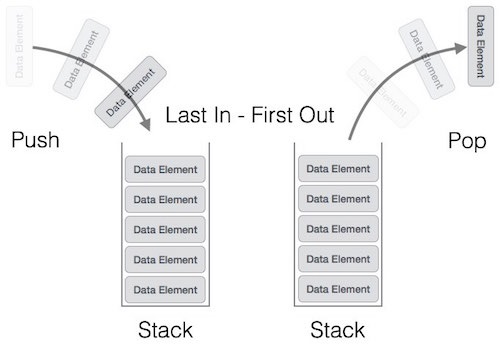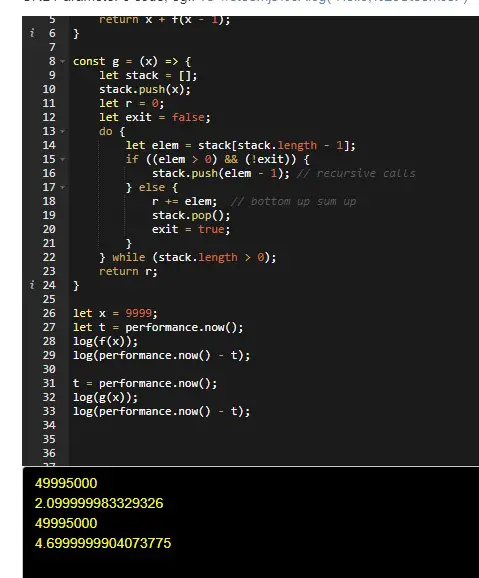Recursion is an important programming concepts. Recursion can be used to simplify your algorithm implementation but at a cost of possible stack-over-flow pitfalls. This tutorial will provide a simple-to-follow example and you will learn:
- how recursion works.
- how to generally convert them to non-recursion approaches.
- the advantages and disadvantages of recursions.
In order to understand this tutorial, you will need to:
- understand the data structure Stack
- understand at least C-style programming language
Recursion and Stack
We can define a function f() that takes an integer parameter x and compute the sum from 1 to x inclusive. It can be defined in ES6 – Javascript as a recursive approach:
1 2 3 4 5 6 | const f = (x) => { if (x === 0) { // exiting condition return 0; } return x + f(x - 1); } |
const f = (x) => {
if (x === 0) { // exiting condition
return 0;
}
return x + f(x - 1);
}For example, to compute f(5) it will be unrolled to:
5 + f(4) ----> 4 + f(3) ----------> 3 + f(2) --------------> 2 + f(1) --------------------> 1 + f(0) -------------------------> 0 <----- exiting condition met.
So actually, the computer will compute the value for f(0) first, then f(1), f(2)… and so on. The values will be added from bottom to the top.
Recursion is a function call to itself. The computer saves the current stats in the current function stack, call recursions and restore the stack upon its return. Computer programs have a fixed size of stack, and if you have too many recursive calls that will build up the recursion depth, which will overflow your stack – known as StackOverFlow
A stack is a First-In-Last-Out data structure, where elements are pushed on top of each other and they are retrieved later in the reverse order.
In Javascript, we can use the array to emulate the stack:
1 2 3 4 5 | let stack = []; stack.push(1); // stack is now [1] stack.push(5); // stack is now [1, 5] let i = stack.pop(); // stack is now [1] console.log(i); // displays 5 |
let stack = []; stack.push(1); // stack is now [1] stack.push(5); // stack is now [1, 5] let i = stack.pop(); // stack is now [1] console.log(i); // displays 5
So, by using stack, we can emulate the recursive approach:
1 2 3 4 5 6 7 8 9 10 11 12 13 14 15 16 17 | const g = (x) => { let stack = []; stack.push(x); let r = 0; let exit = false; do { let elem = stack[stack.length - 1]; // peek the stack if ((elem > 0) && (!exit)) { stack.push(elem - 1); // recursive calls } else { r += elem; // bottom up - sum up stack.pop(); exit = true; } } while (stack.length > 0); return r; } |
const g = (x) => {
let stack = [];
stack.push(x);
let r = 0;
let exit = false;
do {
let elem = stack[stack.length - 1]; // peek the stack
if ((elem > 0) && (!exit)) {
stack.push(elem - 1); // recursive calls
} else {
r += elem; // bottom up - sum up
stack.pop();
exit = true;
}
} while (stack.length > 0);
return r;
}Unlike the intuitive recursive approach i.e. f(), this approach involves manual manipulations of the stack. Whenexit is true, all values will be sum up from bottom to the top. However, as the stack size can grow dynamically, it does not have the StackOverFlow problem.
Let’s compare the performances of both approaches via JS performance.now(). You can run the above JS code in this tutorial by using SteemJS Editor.
We can see that the recursions are performing better as nowadays the computers (compilers or interpreters) are very good at optimising the recursion. And recursions are easy to implement and straightforward in illustrating the algorithms/ideas.
However, most recursions can be eliminated by using a better algorithms. For example, the f() can be implemented using the iterative loop, or even just a pure mathematical formula.
All the code used in this tutorial has been uploaded to my github:
https://github.com/DoctorLai/tutorial-code/blob/master/recursion-and-stack.js
Support me and my work as a witness by
Some of my contributions: SteemIt Tools, Bots, APIs and Tutorial
–EOF (The Ultimate Computing & Technology Blog) —
loading...
Last Post: The SteemJs Editor - Test Your SteemJs Code Snippet Easily
Next Post: SteemVBS - Adding Reputation, GetProfile, GetWitnessVotes, ValidateAccountName

